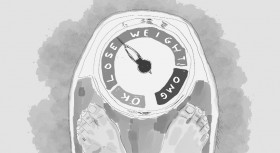How many times do I have to encounter the judgmental questions and endure the curious stares of young shop attendants in stores I visited to get the clothes or shoes or stuffs I like?
When I shop for clothes, I look for something less “mainstream”. Some stores provide what I search for, but it comes with a bonus, a heart-shattering question: “Cari apa, pak (sir)?” or “Cari apa, oom (uncle)?”
For crying out-loud, I go to these stores in Jakarta, where silver spoon-fed lads spend Rp 500,000 on a thin plain t-shirt with a tiny logo just above their left nipple, for my self. I shop for my own clothes. I was not there to buy gifts for my son, not even my Godson. A 40-something-year-old man like me deserves to wear clothes that make a bold statement without having to be addressed the same way the shopkeepers address the husband of their aunts.
Is that too much to ask?
Perhaps they think I should buy a boring vertical stripe shirt in one of those outlets for grown-up people. But is it a sin if a man my age admires the youthful, fresh, relaxed and recent look of young men, whom he can very much relate to? Not because he wants to be part of the crowd, but simply because the look suits his fashion style and personality.
Yes, I have the fashion sensibility of hipsters, the demography of young people who treat me as if I was a friend of their parents.
And this happens everywhere.
At a hip bookstore, the cashier calls me pak as he handed me the books I purchased. At the famous coffee shop frequented by young urban Indonesians there only to be seen, the barista would write down my name with the prefix Pak. I respect their courtesy, but couldn’t they at least distinguish me in my hipster accoutre from the rest of the bapaks in the queues? I consider myself lucky if I met a barista who called me mas or kak (both Indonesian title for big brother).
Have I been going to places that do not represent the demography I belong to? Or am I merely someone who does not dress my age? Or, worse, have I been too much in denial to accept the fact that I am too old for some things?
I contemplated these questions, and came out with a negative.
It’s not that I don’t dress properly. I read male fashion magazines, which I have been using as a reference, since I was younger, but my taste tends to go for the less formal and dressy. I feel awkward in a formal suit, so I adjust and play with my outfits. Long before Justin Timberlake did it, I had worn sneakers with my suit.
In the early ‘90s when I went home for my a long weekend holiday, I irritated my late mom for wearing a designer item’s washed-batik sarong over a pair of baggy ankle-length pants, with white plain oblong, sneakers, and a backpack to go to a mall. The next day I wore torn jeans short and oversized long-sleeved shirt I found in my father’s closet and leather sandals to go to the movies.
My best friend, someone who splurges on branded fashion items, remarked that I had a distinctive and original style that never hurt his eyes. On that fine Saturday when he gave me that compliment, I was wearing a sparkling silver shirt to a party with him. And I was in my late 20s. So you can see that my taste for the non-mainstream fashion predated this batch of young hipsters.
Back to my life today as an aging hipster, it’s not that I’m an ungracious person. I return courtesy to those who greet me politely, whether genuinely or as part of their company’s SOP (right hand on the left upper left chest, fake smile and pre-scripted greetings). I smile back and thank them.
That is not the meat of matter.
As someone who has spent over two decades working in the area of branding and communication, this is a question of how a brand owner equips its employees with the capability to establish some relevance between their brand and their main target audience, as well as with those who feel aspired to the brand, even if they are not the designated target audience.
They can start by educating their front-liners on how to embrace everyone who feel attracted to the brand as their peer, people they hang-out with because they share similar tastes, habits and interests; or people who like to make fashion statement like them. And they definitely should embrace those who dress the part representing the demography their brand is talking to when they visit the outlet – Exhibit A: Me – instead of making these people feel old.
The next step is how to train the shop attendants and other front-liners to be able to walk in the customers’ shoes, to have the capacity for empathy. One may have spent hours and loads of money to show up to their outlet looking like a natural-born regular. Appreciate the effort.
Also, the front-liners need to learn how to develop relationship with the visitors or consumers with their brand. Someone who does not bake will not be bothered to visit a baking supplies shop, right? Similarly, someone who identifies with the laidback style of a hipster would not spend much time at a store that caters to the more formal and brand-conscious people.
It goes back to how the brand owners understand and are willing to embrace and appreciate their target market’s sense of relevance towards their brands.
I admit I may be a demographically wrong hipster, who collects cool sneakers instead of branded leather shoes. But as a customer, I deserve to be treated the same way as other customers, even if I’m twice their age.
About Harry S. Darmosoewito
Harry has been going through the ups and downs of public relation and marketing communication for two decades before deciding to embark on a spiritual journey about seven years ago. Harry is a certified meditator, intuitive and energetics healer. Now he combines the two worlds, while embracing and enjoying all the good things Life has to offer. Follow him on Twitter @hareeharee and Instagram hareeharee.








Comments